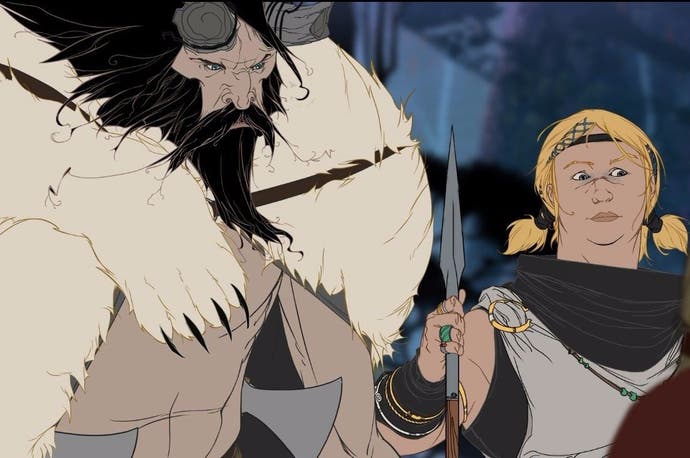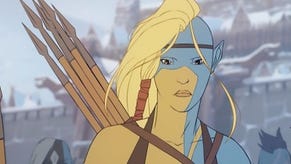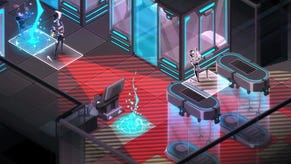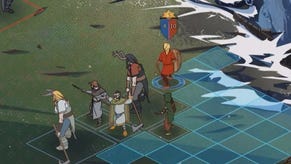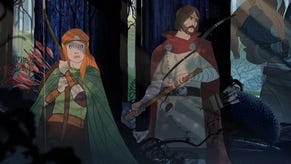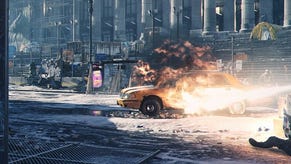The Banner Saga 2 Review
No sign of flagging.
There's a character in The Banner Saga called Egil. You probably won't remember much about him even if you played the first game, aside from the fact that he carries a big shield and clearly fancies the protagonist's daughter, Alette. He's alright, but a little forgettable in what becomes an epic tale of giants, magic and a world-devouring serpent. In fact, according to the developers, only something like five percent of players managed to keep him alive throughout the events of the first game. A fairly minor character, then. But as part of that five percent of players (not bragging, just saying), I was delighted to see Egil play a small role in The Banner Saga 2 after importing my save file. These games delight in conveying the terrible burdens of leadership and so it feels especially important that the choices made so far have meant something.
In fact, as I began this second game in what will be a trilogy, I realised that alongside Egil, something like half of the heroes in my group could have been killed off in The Banner Saga had I opted for a different narrative choice. This was somewhat overwhelming to begin with, as each character retains their level, abilities and items from the previous game - that ends up being a lot of numbers to refamiliarise yourself with. But crucially, it felt like I was leading my caravan, my survivors.
Of course, there's an overarching plot that every player will experience in The Banner Saga 2 regardless, but along the way I was impressed by the small moments in which characters - characters that didn't have to be there - cropped up with extra dialogue, sometimes offering an alternative approach to a problem I'd encountered. I was expecting Stoic to face the same hurdle that tripped Telltale Games with titles like The Walking Dead, in which the player's decisions usually feel temporary. A character saved in one episode is likely to die in the next to avoid a branching narrative that could quickly spiral out of control. The Banner Saga 2 does a lot less with its minor characters, but as a result, it manages to tell a story that truly is determined by the player. Your decisions aren't delaying the fate of each hero, but rather, deciding it.
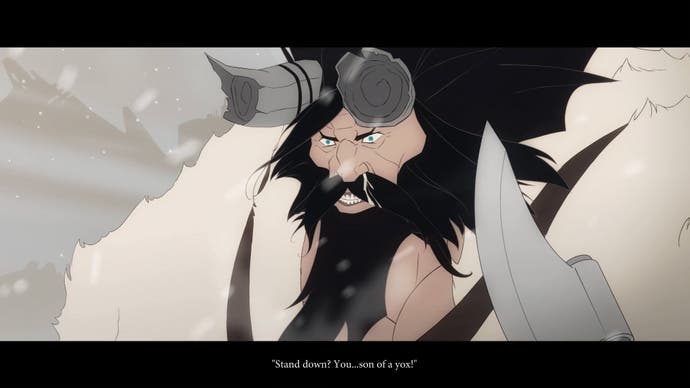
So yes, I'm impressed that forgettable Egil and his pals show up (or don't!), but there is one choice made in the final moments of The Banner Saga that much more dramatically alters how its sequel plays out. The destination will remain the same, sure, but the entire tone of this sequel's journey is changed depending on what happened in the first game's final battle. With all of this in mind, I'd strongly advise that you play through this series from start to finish and not to begin your story with The Banner Saga 2. Starting here is an option - you can use a default game state - but in doing so, you'll lose a big part of what makes these games special.
Okay, The Banner Saga 2 remembers you, and that's great. Outside of that, the game feels pretty familiar - for better and worse. Just like its predecessor, it's a phenomenally attractive game to travel through. From time to time your caravan will push forwards, unhindered, across some impossible vista, and it's a genuine pleasure to just sit back and watch that happen. These brief moments of respite between battles are the reminder we need that this is probably a world worth saving. That feeling is amplified tenfold by an incredible score from the Colorado Symphony, which, by the way, changes depending on the decision you made at the end of the last game! Okay, I'm done talking about that now.
The combat has seen a few interesting changes, largely driven by the handful of new unit types introduced. Both you and the enemy forces will have the option to take advantage of stealth, using relatively weak units that can do increased damage when landing a surprise attack. There's a new poet class to consider - a poet! - which offers some pretty hefty buffs across the battlefield, but you'll need to keep them well protected. It's also possible, at one point, to recruit a brand new race of heroes, which I won't spoil, other than saying they're significantly more mobile than the rest of your group. On top of the potentially large roster of heroes you're bringing with you from The Banner Saga, this gives you plenty of options to consider when selecting your six-person team.
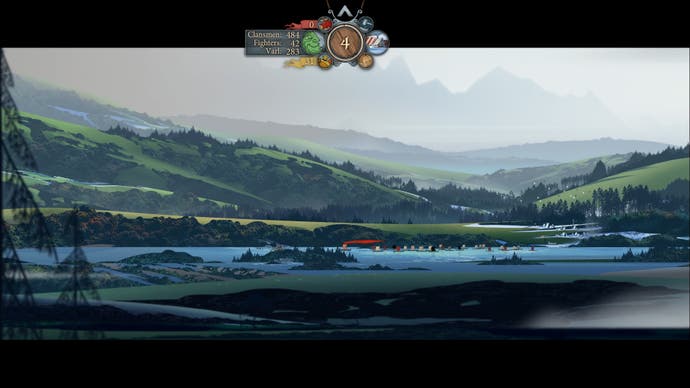
Whilst we're on that topic, The Banner Saga 2 does a much better job at explaining how to make best use of your heroes as an actual group, thanks to a new camp trainer that rewards you for completing his challenges. One character, Bolverk, has an unrivalled potential for damage dealing (thanks to a second attack he can make each turn), but it's difficult to keep him in fighting shape and ensure that he's in the best position each turn. Well, as pointed out in one of the trainer's early challenges, there are other heroes that can help deal with both of those problems. Suddenly Bolverk made an awful lot more sense to me, and quickly became my first pick for most encounters. Every time you gain access to a new type of unit, there's a challenge waiting to show you just how they're meant to be played. This proves to be a big help.
As a result, I think I got more out of the combat in this sequel than I did in the original game. The battles themselves are a little more dynamic, too. You'll still run into fights that ask you to kill every single enemy unit, but The Banner Saga 2 introduces other objectives too. Take out a specific enemy and the rest will flee, or hold off a dredge force long enough for a couple of your units to clear an avalanche blocking the road. It's a nice change of pace in a game that still, for the most part, sees you fighting the same enemy types over and over.
Unfortunately Stoic hasn't been able to fix what is perhaps the biggest problem facing The Banner Saga series. Figuring out interesting ways to combine your units' strengths on the battlefield may be a fun exercise, but fundamentally, the combat itself is missing something vital.
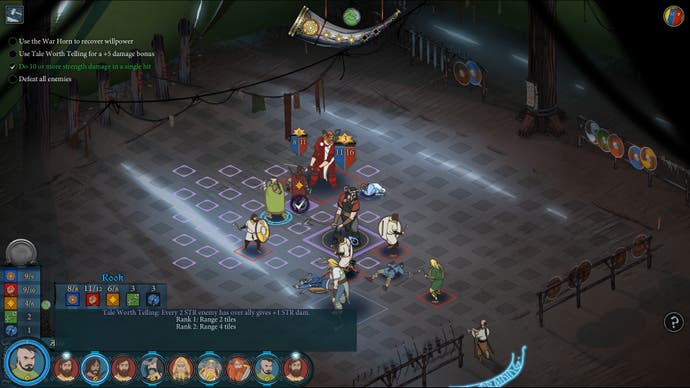
As it stands, the player and computer alternate turns, controlling just a single unit each time. This will always happen until one side has just a single unit left, at which point the battle enters a 'pillage' phase and the larger force is allowed to take actions with all its units before the losing side gets a chance to respond. On paper, this sounds like it could work. Combine this setup with hero abilities that can push enemy units back in the turn order and you have what could be a fairly interesting battle system.
The problem comes with the fact that a unit's hit points also act as their potential damage output. A warrior with 14HP will do exactly 14 points of damage with a standard attack, and so damaging that warrior will reduce any further damage he inflicts throughout the remainder of the battle. This means that - in almost every situation - the best way to approach a battle in The Banner Saga 2 is to damage, but not kill, every single enemy on the field. Ideally you want to force the computer to waste entire turns on units with just a single hit point remaining. Only when the entire force is weakened do you actually want to think about killing units and winning the encounter. This ends up being a pretty boring way to think about turn-based combat and I was hoping the sequel would do significantly more to address that.
But just like the first game, there's still so much to love about The Banner Saga 2 that I can't help but overlook this seemingly gigantic flaw. It's a wonderful, wonderful game that draws you in with its brittle art style and its heroes and villains, only to ask of you the most impossible questions. Make your choices, face the consequences, survive the journey. This is a series, that still, to this day, justifies the existence of Kickstarter. It's beautiful and it's sad, and despite its stilted approach to turn-based combat, is undeniably worth your time.
